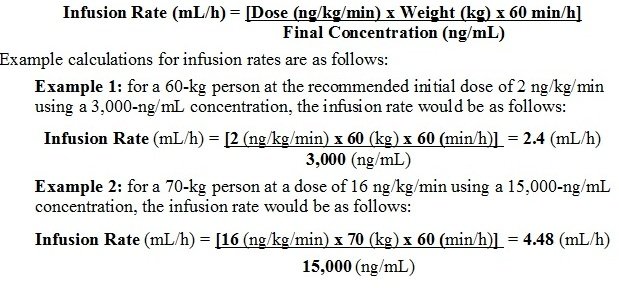Drug Detail:Flolan (Epoprostenol [ ee-poe-prost-en-ol ])
Generic Name: EPOPROSTENOL SODIUM 0.5mg
Dosage Form: injection, powder, lyophilized, for solution
Drug Class: Agents for pulmonary hypertension
Reconstitution
Each vial is for single use only; discard any unused diluent or unused reconstituted solution.
Select a concentration for the solution of FLOLAN that is compatible with the infusion pump being used with respect to minimum and maximum flow rates, reservoir capacity, and the infusion pump criteria listed below [see Dosage and Administration (2.3)].
Using aseptic technique, reconstitute FLOLAN only with pH 12 STERILE DILUENT for FLOLAN. Table 1 gives directions for preparing several different concentrations of FLOLAN. See storage and administration time limits for the reconstituted FLOLAN below.
| a Higher concentrations may be prepared for patients who receive FLOLAN long-term. | |
|
To make 100 mL of solution with final concentration of: |
Directions: |
|
3,000 ng/mL |
Dissolve contents of one 0.5‑mg vial with 5 mL of sterile diluent. Withdraw 3 mL and add to sufficient sterile diluent to make a total of 100 mL. |
|
5,000 ng/mL |
Dissolve contents of one 0.5‑mg vial with 5 mL of sterile diluent. Withdraw entire vial contents and add sufficient sterile diluent to make a total of 100 mL. |
|
10,000 ng/mL |
Dissolve contents of two 0.5‑mg vials each with 5 mL of sterile diluent. Withdraw entire vial contents and add sufficient sterile diluent to make a total of 100 mL. |
|
15,000 ng/mLa |
Dissolve contents of one 1.5‑mg vial with 5 mL of sterile diluent. Withdraw entire vial contents and add sufficient sterile diluent to make a total of 100 mL. |
Storage and Administration Limits for Reconstituted FLOLAN
- •
- Freshly prepared reconstituted solutions or reconstituted solutions that have been stored at 2°C to 8°C (36°F to 46°F) for no longer than 8 days can be administered up to:
- •
- 72 hours at up to 25°C (77°F).
- •
- 48 hours at up to 30°C (86°F).
- •
- 24 hours at up to 35°C (95°F).
- •
- 12 hours at up to 40°C (104°F).
- •
- Reconstituted solutions can be used immediately. Refrigerate at 2°C to 8°C (36°F to 46°F) if not used immediately.
- •
- Protect from light.
- •
- Do not freeze reconstituted solutions.
Dosage
Initiate intravenous infusions of FLOLAN at 2 ng/kg/min. Alter the infusion by 1- to 2-ng/kg/min increments at intervals sufficient to allow assessment of clinical response. These intervals should be at least 15 minutes.
During dose initiation, asymptomatic increases in pulmonary artery pressure coincident with increases in cardiac output may occur. In such cases, consider dose reduction, but such an increase does not imply that chronic treatment is contraindicated.
Base changes in the chronic infusion rate on persistence, recurrence, or worsening of the patient's symptoms of pulmonary hypertension and the occurrence of adverse vasodilatory reactions. In general, expect progressive increases in dose.
If dose-related adverse reactions occur, make dose decreases gradually in 2-ng/kg/min decrements every 15 minutes or longer until the dose-limiting effects resolve [see Adverse Reactions (6.1, 6.2)]. Avoid abrupt withdrawal of FLOLAN or sudden large reductions in infusion rates [see Warnings and Precautions (5.2)].
Following establishment of a new chronic infusion rate, measure standing and supine blood pressure for several hours.
Taper doses of FLOLAN after initiation of cardiopulmonary bypass in patients receiving lung transplants.
Administration
Initiate FLOLAN in a setting with adequate personnel and equipment for physiologic monitoring and emergency care.
Inspect parenteral drug products for particulate matter and discoloration prior to administration whenever solution and container permit. If either particulate matter or discoloration is noted, do not use.
Administer continuous chronic infusion of FLOLAN through a central venous catheter. Temporary peripheral intravenous infusion may be used until central access is established. Do not administer bolus injections of FLOLAN.
The ambulatory infusion pump used to administer FLOLAN should: (1) be small and lightweight, (2) be able to adjust infusion rates in 2‑ng/kg/min increments, (3) have occlusion, end-of-infusion, and low-battery alarms, (4) be accurate to ± 6% of the programmed rate, and (5) be positive-pressure‑driven (continuous or pulsatile) with intervals between pulses not exceeding 3 minutes at infusion rates used to deliver FLOLAN. The reservoir should be made of polyvinyl chloride, polypropylene, or glass. Use a 60-inch microbore non-di-(2-ethylhexyl)phthalate (DEHP) extension set with proximal antisyphon valve, low-priming volume (0.9 mL), and in-line 0.22-micron filter.
Preparation and administration materials containing polyethylene terephthalate (PET) or polyethylene terephthalate glycol (PETG) may become damaged when used with FLOLAN prepared with pH 12 STERILE DILUENT for FLOLAN and therefore must not be used.
Consult the manufacturer of the sets to confirm that they are considered compatible with highly alkaline solutions, such as FLOLAN prepared with pH 12 STERILE DILUENT for FLOLAN.
To avoid interruptions in drug delivery, the patient should have access to a backup infusion pump and intravenous infusion sets.
Do not administer or dilute reconstituted solutions of FLOLAN with other parenteral solutions or medications. Consider a multi‑lumen catheter if other intravenous therapies are routinely administered.
Select a concentration for the solution of FLOLAN that is compatible with the infusion pump being used with respect to minimum and maximum flow rates, reservoir capacity, and the infusion pump criteria listed above. When administered chronically, prepare FLOLAN in a drug delivery reservoir appropriate for the infusion pump with a total reservoir volume of at least 100 mL, using 2 vials of pH 12 STERILE DILUENT for FLOLAN.
Generally, 3,000 ng/mL and 10,000 ng/mL are satisfactory concentrations to deliver between 2 to 16 ng/kg/min in adults. Higher infusion rates, and therefore, more concentrated solutions may be necessary with long‑term administration of FLOLAN.
Infusion rates may be calculated using the following formula:





